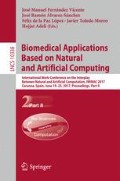Abstract
Speech articulation is conditioned by the movements produced by well determined groups of muscles in the larynx, pharynx, mouth and face. The resulting speech shows acoustic features which are directly related with muscle neuromotor actions. Formants are some of the observable correlates most related to certain muscle actions, such as the ones activating jaw and tongue. As the recording of speech is simple and ubiquitous, the use of speech as a vehicular tool for neuromotor action monitoring would open a wide set of applications in the study of functional grading of neurodegenerative diseases. A relevant question is how far speech correlates and neuromotor action are related. This question is answered by the present study using electromyographic recordings on the masseter and the acoustic kinematics related with the first formant. Correlation measurements help in establishing a clear relation between the time derivative of the first formant and the masseter myoelectric activity. Monitoring disease progress by acoustic kinematics in one case of Amyotrophic Lateral Sclerosis ALS is described.
Access this chapter
Tax calculation will be finalised at checkout
Purchases are for personal use only
References
Demonet, J.F., Thierry, G., Cardebat, D.: Renewal of the neurophysiology of language: functional neuroimaging. Physiol. Rev. 85, 49–95 (2005)
Yunusova, Y., Weismer, G., Westbury, J.R., Lindstrom, M.J.: Articulatory movements during vowels in speakers with dysarthria and healthy controls. J. Speech Lang. Hear. Res. 51(3), 596–611 (2008)
Phinyomark, A., Quaine, F., Charbonnier, S., Serviere, C., Tarpin-Bernard, F., Laurillau, Y.: EMG feature evaluation for improving myoelectric pattern recognition robustness. Expert Syst. Appl. 40, 4832–4840 (2013)
Dromey, C., Jang, G.O., Hollis, K.: Assessing correlations between lingual movements and formants. Speech Commun. 55(2), 315–328 (2013)
Deller, J.R., Proakis, J.G., Hansen, J.H.L.: Discrete-Time Processing of Speech Signals. Macmillan, NewYork (1993)
Green, J.R.: Mouth matters: scientific and clinical applications of speech movement analysis. Perspect. Speech Sci. Orofacial Disord. 25, 6–16 (2015)
Wu, P., Gonzalez, I., Patsis, G., Jiang, D., Sahli, H., Kerckhofs, E., Vandekerckhove, M.: Objectifying facial expressivity assessment of Parkinson’s patients: preliminary study. Comput. Math. Methods Med. 2014 (2014). Article no. 427826. http://dx.doi.org/10.1155/2014/427826
Gómez-Vilda, P., Londral, A.R.M., Rodellar-Biarge, V., Ferrández-Vicente, J.M., de Carvalho, M.: Monitoring amyotrophic lateral sclerosis by biomechanical modeling of speech production. Neurocomputing 151, 130–138 (2015)
Webb, A.R.: Statistical Pattern Recognition. Wiley, Chichester (2002)
Salicrú, M., Morales, D., Menéndez, M.L., Pardo, L.: On the applications of divergence type measures in testing statistical hypotheses. J. Multivar. Anal. 51, 372–391 (1994)
Acknowledgments
This work is being funded by grants TEC2012-38630-C04-01, TEC2012-38630-C04-04 and TEC2016-77791-C4-4-R from the Ministry of Economic Affairs and Competitiveness of Spain.
Author information
Authors and Affiliations
Corresponding author
Editor information
Editors and Affiliations
Rights and permissions
Copyright information
© 2017 Springer International Publishing AG
About this paper
Cite this paper
Gómez-Vilda, P. et al. (2017). Relating Facial Myoelectric Activity to Speech Formants. In: Ferrández Vicente, J., Álvarez-Sánchez, J., de la Paz López, F., Toledo Moreo, J., Adeli, H. (eds) Biomedical Applications Based on Natural and Artificial Computing. IWINAC 2017. Lecture Notes in Computer Science(), vol 10338. Springer, Cham. https://doi.org/10.1007/978-3-319-59773-7_53
Download citation
DOI: https://doi.org/10.1007/978-3-319-59773-7_53
Published:
Publisher Name: Springer, Cham
Print ISBN: 978-3-319-59772-0
Online ISBN: 978-3-319-59773-7
eBook Packages: Computer ScienceComputer Science (R0)

